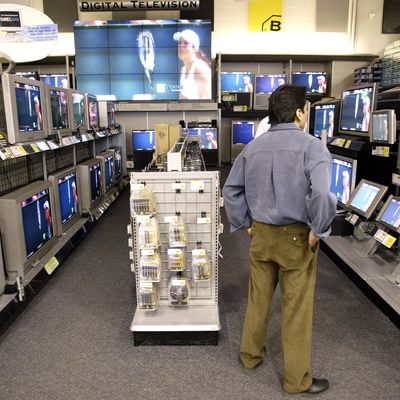
For the first time in ages, I went into a Best Buy last week.
After a cross-country road trip spent mostly listening to terrible FM radio in the heartland, I decided to switch out my car stereo for one compatible with my iPod. I went into my local blue-and-yellow electronics retailer, found the car audio section, picked out a cheap stereo with an aux jack, and waited for the store clerk to arrive. He did, after about ten minutes, armed with a surly disposition and a battery of questions: Could I wait an hour for the installers to free up? Did I want to go with the custom mount or try a standard one for a different car model? Did I want the extended warranty, too?
I walked out without making a purchase, the whole experience having left a slight bitter taste in my mouth about the old-school approach to big-box electronics retailing. There must be, I remember thinking, another store, somewhere (probably online), that can do a better and cheaper job of giving me what I need.
That sensation, writ large, is part of what has made the past few years so painful for Best Buy, and might help explain why its stock price has fallen 60 percent in the last five years.
If you haven’t been following the twists and turns of the Best Buy saga, here’s a quick refresher: After spending a decade getting pummeled by the rise of Amazon, the disappearance of physical CDs, and the encroach of Apple’s own retail stores, Best Buy saw its longtime CEO, Brian Dunn, quit last April amid an investigation into a romantic relationship he had with a 29-year-old female employee.
Dunn’s departure hurt, but not as much as the $1.7 billion quarterly loss — yes, quarterly, as in, made the equivalent of Barry Diller’s net worth disappear in three months — the company had reported two weeks earlier.
Since Dunn left, things have only gotten worse. Losses have mounted, and the company has announced plans to close some stores, drastically shrink others, and lay off more than 2,000 workers in order to cut costs. This week, the company announced that its second-quarter profits had dropped 90 percent, withdrew its earnings guidance for the rest of the year, and appointed as permanent CEO a largely unknown Frenchman who gave this confidence-inspiring quote upon his appointment: “Rightly or wrongly, here I am.”
Recently, Best Buy’s founder, Dick Schulze, got so fed up with his company’s death spiral that he made an offer to take the entire thing private, at a price of $24 to $26 per share. That’s a good deal given the company’s current stock price, which is hovering around the $18 mark. But instead of accepting the offer and telling Schulze, “Good luck with the turnaround!” on the way to the the beach, the retailer’s board instead locked horns with him over dumb things like standstill agreements and the timing of a potential hostile offer. (See Dan Primack’s excellent explanation of Best Buy’s shortsightedness.)
What’s sad about Best Buy’s decision to put up roadblocks to a buyout is that it should really want to go private. With such dismal losses even despite growth in its core business units (same-store sales of computers and mobile phones, a unit that accounts for 44 percent of Best Buy’s U.S. revenue, grew 8 percent in the second quarter), Best Buy has proven that it needs more than a turnaround. It needs to tear the walls down, level the foundation, and start over. And that kind of turnaround is hard, if not impossible, to pull off with shareholders and analysts breathing down your neck.
The bigger problem, though, is that the consumer electronics market just doesn’t look the way it did in the nineties and early aughts, when Best Buy’s well-arranged cornucopia of computers, appliances, video games, and CDs made it a one-stop hub. The Internet now serves that function. (As Farhad Manjoo deftly put it back in April, the company’s bloated inventory and unhelpful staff makes today’s typical Best Buy nothing more than “a showroom for Amazon.”) And the fates of CompUSA and Circuit City should be all the warning Best Buy’s board needs about the wisdom of relying on big-box electronics retail demand.
I’d wager that Best Buy could survive by dramatically cutting back on its offerings and focusing on service, thereby turning itself into some hybrid of the Apple store — a clean, friendly hardware shop with a limited inventory, as Manjoo suggested — and a nationwide, multi-platform version of Tekserve, the impressive and hip-looking Mac service center in Manhattan that fixes busted iPads and MacBooks and sells all manner of Apple accessories.
Whether Schulze, who built Best Buy into a behemoth in a very different consumer electronics retail world, could pull off a complete makeover like that — or would even attempt it — is anyone’s guess. But allowing him to take the company private and execute a massive shift in strategy would give it, at the very least, some new energy. And new energy, as my ill-fated car stereo shopping trip last week proved, may be what Best Buy needs most.





























